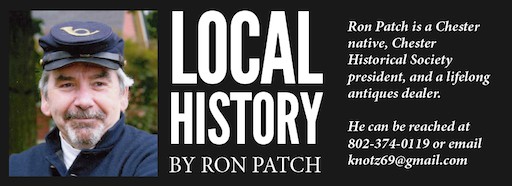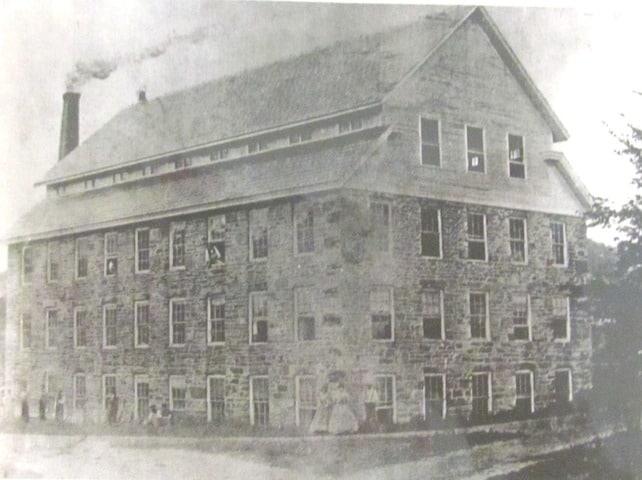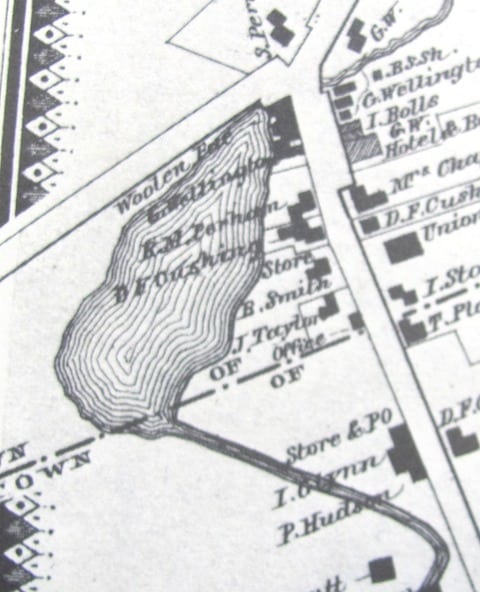
Many will know the old stone ruins in Cambridgeport. Several readers contacted me with photos or information they had.

From Lyman Hayes’ “1907 History of Rockingham”
“In 1836 Earl & Campbell, who owned the woolen mill at Saxtons River, went to Cambridgeport and erected an extensive stone woolen-mill building at a cost of over $31,000. During the panic of the next year the firm failed and the mill was not utilized for some years.
“In 1857 George Perry, Philip Fletcher Perry, J.A. Farnsworth, B. Scofield and T. Hoit bought the mill and all its belongings for $5,000. They put in new machinery and an engine for power and under their management the enterprise was successful.
“Under different ownerships the mill had varying success and it was burned down twice. For many years it furnished the major part of business of the village, the only other manufacturing enterprise being a soapstone mill a short distance up the river.
“The stone walls of the original woolen mill are those now holding the saw and grist-mill. After its last destruction by fire about 1878, while owned by Robert Fitton, it was not utilized as a woolen factory.”
Panic of 1837
The Panic of 1837 was a crippling depression, in part due to actions taken by President Andrew Jackson. The woolen mill was built in 1836. One year later, our economy crashed. All was lost.
I checked the inflation calculator: $31,000 in 1836 would equal $914,366 today.
From Wikipedia
“Panic of 1837 was a financial crisis in the United States that touched off a major depression, which lasted until the mid-1840s. Profits, prices, and wages went down, Westward expansion was stalled, unemployment went up, and pessimism abounded.

“The panic had both domestic and foreign origins. Speculative lending practices in the West, a sharp decline in cotton prices, a collapsing land bubble, international specie flows, and restrictive lending policies in Britain were all factors. The lack of a central bank to regulate fiscal matters, which President Jackson had ensured by not extending the charter of the Second Bank of the United States, was also key.
“This ailing economy of early 1837 led investors to panic – a bank run ensued – giving the crisis its name. The run came to a head on May 10, 1837, when banks in New York City ran out of gold and silver. They suspended specie payments and would no longer redeem commercial paper in specie at full face value. A significant economic collapse followed.
“Despite a brief recovery in 1838, the recession persisted for approximately seven years. Nearly half of all banks failed, businesses closed, prices declined, and there was mass unemployment. From 1837 to 1844 deflation in wages and prices was widespread. The lack of deposit insurance deepened the Panic. By 1850 the economy was booming again, a result of increased specie flows from the California Gold Rush.”
The stone mill was last used as a sawmill. Today, the stone walls stand although they’re crumbling. There was a large millpond that supplied waterpower for the mill. In the 1869 Beers Atlas of Windham County, the millpond can clearly be seen.
Early Cambridgeport history Lyman Hayes:
“From Ussiah Wyman a prominent resident of the locality, who died about 1888 at the age of nearly ninety years, is authority for the following statement in relation to the early history of the place:
“In 1792 a Mr. Adams came from the settlement at Saxtons River, making his way by marked trees, to what is now Cambridgeport, and built a hut, moving his family thereto in the same year. He remained only a short time, however, and for some years no other settlement was made.
“In 1810 some parties by the name of Bulling purchased a tract of one thousand acres of land in this vicinity, including the present site of the village and extending over into the town of Athens, upon which they erected mills, where the village now is.
“In 1812, Nathaniel Bennett purchased the mills, erected two dwellings and the following year the first school-house was built.
“In 1814 Simeon Evans built the first store and commenced trade. During this year the first road was laid through, running east of the present factory pond, and over the hill to Grafton. Mr. Evans also built the old tavern, which he occupied a few years. He died in 1819…
“It derives its name from J.T. Cambridge, who commenced the clothiers business here in 1825.”
This week’s old saying: “One Smith & Wesson beats four aces.”